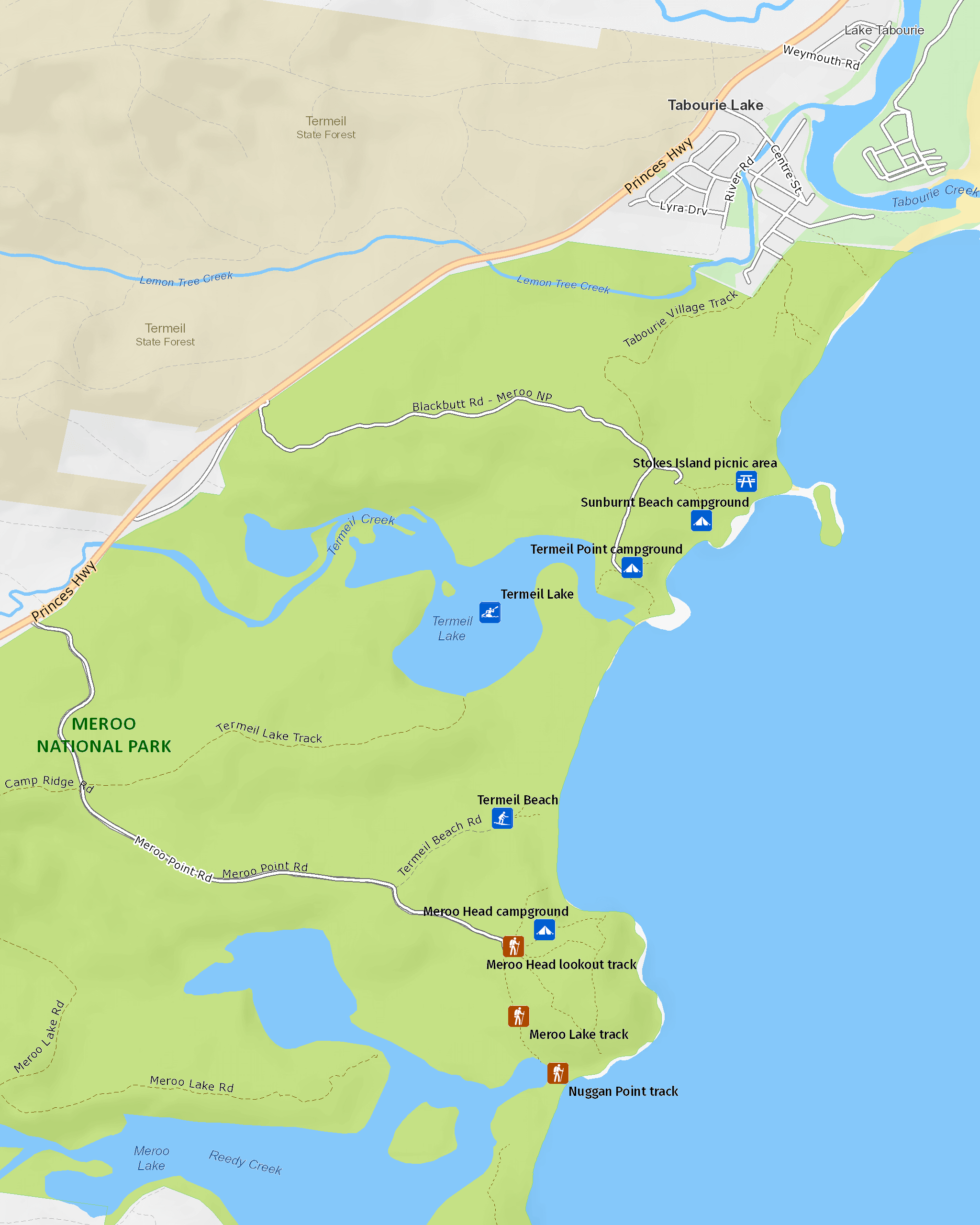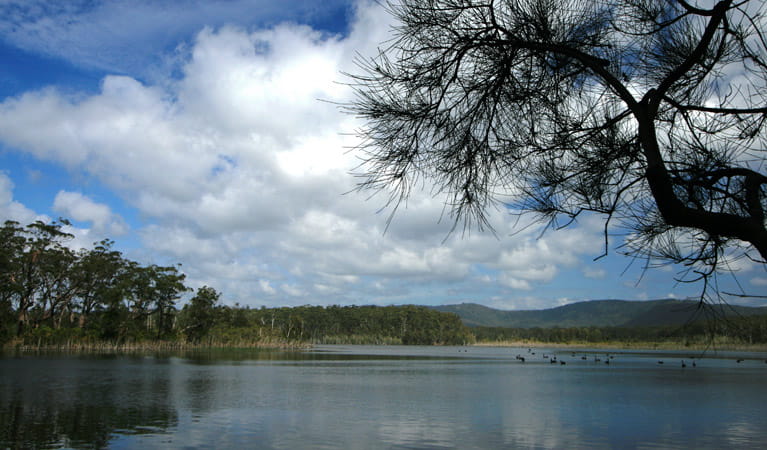Termeil Lake
Meroo National Park
Overview
Termeil Lake is a peaceful refuge for wildlife and visitors alike, with options for fishing, swimming, paddling, picnicking and birdwatching in pristine surroundings.
- Where
- Meroo National Park in South Coast
- What to
bring - Drinking water, sunscreen, hat, binoculars
- Please note
Set before a dramatic backdrop of forested hills, Termeil Lake provides a peaceful refuge for wildlife and visitors alike.
No powerboats can access the area, so there’s nothing to disturb the peace while you are paddling and exploring the backwaters and tributaries. Stop along the way for a picnic or head back to the campground at Termeil Point to enjoy a hot meal around the campfire.
Enjoy swimming in the clear waters and unwind as you cast your fishing line from the lake’s edge. Binoculars are a must if you’re enthusiastic about birdwatching, as you’re likely to see waterbirds like cormorants, ducks and swans. Look out for sea eagles resting on a nearby branch and watch for whistling kites soaring high above.
Map

Map legend

Local alerts
For the latest updates on fires, closures and other alerts in this area, see https://www.nationalparks.nsw.gov.au/things-to-do/canoeing-paddling-experiences/termeil-lake/local-alerts
Park info
- in Meroo National Park in the South Coast region
Meroo National Park is always open but may have to close at times due to poor weather or fire danger.
Visitor info
All the practical information you need to know about Termeil Lake.
Getting there and parking
Termeil Lake is in the Termeil Point precinct in the southern part of Meroo National Park. To get there:
- Travel south on Princes Highway from Ulladulla
- Approximately 14km south of Ulladulla turn left into Blackbutt Road
- Continue for approximately 2km to the fork in the road
- Turn right and follow for approximately 600m to the Termeil Point campground carpark
Road quality
Check the weather before you set out as the road to Termeil Lake can become boggy when it rains.
- Unsealed roads
Vehicle access
- All roads require 4WD vehicle
Weather restrictions
- All weather
Parking
Parking is available at Termeil Point.
Best times to visit
There are lots of great things waiting for you in Meroo National Park. Here are some of the highlights.
Autumn
Enjoy the serenity on the water while paddling a canoe or kayak in one of the park's coastal lakes.
Spring
Escape your busy city life and spend a night at one of the beachside camping areas.
Summer
Head to Termeil Beach or Pot Holes Beach for a day of swimming, surfing and beach fishing.
Winter
Rug up and take in spectacular coastal views from Nuggan Point walking track.
Weather, temperature and rainfall
Summer temperature
Average
9°C and 27°C
Highest recorded
39.8°C
Winter temperature
Average
0°C and 13°C
Lowest recorded
-9°C
Rainfall
Wettest month
March
Driest month
September
The area’s highest recorded rainfall in one day
489.6mm
Facilities
Drinking water is limited or not available in this area, so it’s a good idea to bring your own.
Toilets
- Flush toilets
Carpark
Maps and downloads
Permitted
Fishing
A current NSW recreational fishing licence is required when fishing in all waters.
Prohibited
Pets
Pets and domestic animals (other than certified assistance animals) are not permitted. Find out which regional parks allow dog walking and see the pets in parks policy for more information.
Smoking
NSW national parks are no smoking areas.
Learn more
Termeil Lake is in Meroo National Park. Here are just some of the reasons why this park is special:
Amazing wildlife haven

Meroo and Termeil Lakes are listed in the National Directory of Important Australian Wetlands and stand out for their abundance and diversity of mammals and frogs. The park also has at least 12 threatened wildlife species, including significant populations of the nationally endangered green and golden bell frog. As you explore the coastline keep a lookout to spot dolphins and whales off the coast. Thee's also excellent opportunities for birdwatching at Meroo. You'll see ducks, swans, pelicans, honeyeaters, superb blue wrens and pied oystercatchers. You might also spot sea eagles or an osprey soaring overhead. And if you're really lucky, you might even see a pair of hooded plover. There are less than 25 pairs known to occur in NSW, and the Meroo, Termeil and Willinga Lake entrances are prime breeding habitats for this vulnerable species.
- Meroo Lake walking track Wrap yourself in the tranquillity of calm coastal waters at Meroo Lake walking track. Enjoy paddling, swimming, fishing, birdwatching and walking in a pristine natural landscape.
- Tabourie Lake Tabourie Lake is a beautiful coastal lake ideal for fishing, paddling, windsurfing, swimming, walking and birdwatching.
Pristine natural landscapes

The coastal lakes, foreshores and wetlands you'll find in Meroo are outstanding examples of pristine natural environments. Only 10% of NSW estuaries remain in such a natural condition. This unspoilt landscape supports endangered ecological communities like the swamp oak floodplain forest and bangalay-banksia dry forest and helps to protect vulnerable plant species such as the tangled bedstraw and leafless tongue orchid.
- Meroo Head lookout walking track You can’t miss the spectacular coastal views from Meroo Head lookout walking track. It’s an easy walking track and a great place for birdwatching and whale watching.
- Nuggan Point walking track Go walking or mountain biking on this easy trail. Enjoy breathtaking coastal views, fishing, whale watching and birdwatching at Nuggan Point, then stop at Meroo Beach for a swim.
Rich Aboriginal culture

Meroo National Park forms part of the traditional lands of the Budawang and Murramarang tribes, who are part of the Dhurga language group. Meroo Lake has important spiritual significance for local Aboriginal groups because, along with other lakes in the region, it is connected to the Pigeon House Didthul creation stories that connect them with their country and ancestor spirits. The park is rich with archaeological sites including shell middens, open campsites, artefact scatters, stone arrangements, rock shelters and a burial site.
- Giriwa walking track Discover Aboriginal cultural heritage along Giriwa walking track, in Meroo National Park. Enjoy the natural beauty of Burrill Lake, near Ulladulla, then stop for a picnic, swim or kayak.
Plants and animals protected in this park
Animals
-

Green and golden bell frog (Litoria aurea)
The green and golden bell frog is an endangered Australian frog. Once common on the NSW coast and tablelands, populations have plummeted around 90 percent.
-

Humpback whale (Megaptera novaeangliae)
The humpback whale has the longest migratory path of any mammal, travelling over 5000km from its summer feeding grounds in Antarctica to its breeding grounds in the subtropics. Its playful antics, such as body-rolling, breaching and pectoral slapping, are a spectacular sight for whale watchers in NSW national parks.
-

White-bellied sea eagle (Haliaeetus leucogaster)
White-bellied sea eagles can be easily identified by their white tail and dark grey wings. These raptors are often spotted cruising the coastal breezes throughout Australia, and make for some scenic bird watching. Powerful Australian birds of prey, they are known to mate for life, and return each year to the same nest to breed.

